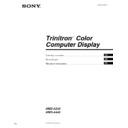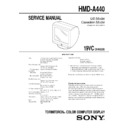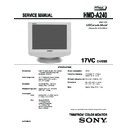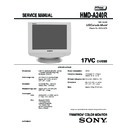Sony HMD-A240 / HMD-A440 Service Manual ▷ View online
US
3
• Trinitron
â
and FD Trinitron
â
are registered trademarks of Sony
Corporation.
• Macintosh is a trademark licensed to Apple Computer, Inc., registered in
the U.S.A. and other countries.
• Windows
â
and MS-DOS are registered trademarks of Microsoft
Corporation in the United States and other countries.
• IBM PC/AT and VGA are registered trademarks of IBM Corporation of
the U.S.A.
• VESA and DDC
ä
are trademarks of the Video Electronics Standard
Association.
•
E
NERGY
S
TAR is a U.S. registered mark.
• All other product names mentioned herein may be the trademarks or
registered trademarks of their respective companies.
• Furthermore, “
ä” and “â” are not mentioned in each case in this manual.
Precautions
Warning on power connections
• Use the supplied power cord.
• Before disconnecting the power cord, wait at least 30 seconds
• Use the supplied power cord.
• Before disconnecting the power cord, wait at least 30 seconds
after turning off the power to allow the static electricity on the
screen’s surface to discharge.
screen’s surface to discharge.
• After the power is turned on, the screen is demagnetized
(degaussed) for about 5 seconds. This generates a strong
magnetic field around the screen which may affect data stored on
magnetic tapes and disks placed near the monitor. Be sure to keep
magnetic recording equipment, tapes, and disks away from the
monitor.
magnetic field around the screen which may affect data stored on
magnetic tapes and disks placed near the monitor. Be sure to keep
magnetic recording equipment, tapes, and disks away from the
monitor.
Installation
Do not install the monitor in the following places:
• on surfaces (rugs, blankets, etc.) or near materials (curtains,
Do not install the monitor in the following places:
• on surfaces (rugs, blankets, etc.) or near materials (curtains,
draperies, etc.) that may block the ventilation holes
• near heat sources such as radiators or air ducts, or in a place
subject to direct sunlight
• in a place subject to severe temperature changes
• in a place subject to mechanical vibration or shock
• on an unstable surface
• near equipment which generates magnetism, such as a
• in a place subject to mechanical vibration or shock
• on an unstable surface
• near equipment which generates magnetism, such as a
transformer or high voltage power lines
• near or on an electrically charged metal surface
• in a dusty or smoky environment
• inside an enclosed rack
• in a dusty or smoky environment
• inside an enclosed rack
Protection
• Do not put foreign objects into the monitor.
• Disconnect the monitor if environment exceeds 60°C/140°F.
• Ensure AC power cord is not trapped under furniture, TV, etc.
• Do not overload wall outlets, extension cords, or convenience
• Do not put foreign objects into the monitor.
• Disconnect the monitor if environment exceeds 60°C/140°F.
• Ensure AC power cord is not trapped under furniture, TV, etc.
• Do not overload wall outlets, extension cords, or convenience
receptacles beyond their capacity.
• Never spill liquid of any kind on the monitor.
Notes on cleaning the screen’s surface
• The screen’s surface is covered with a thin anti-reflective coating
• The screen’s surface is covered with a thin anti-reflective coating
to enhance the ergonomic characteristics of the monitor. To
ensure that the coating is not damaged, use a soft cloth to clean
the screen’s surface. If necessary, use a soft cloth lightly
moistened with a mild detergent solution, such as hand soap, to
wipe the screen.
ensure that the coating is not damaged, use a soft cloth to clean
the screen’s surface. If necessary, use a soft cloth lightly
moistened with a mild detergent solution, such as hand soap, to
wipe the screen.
• Do not use any type of abrasive pad, alkaline cleanser, scouring
powder, or solvents such as alcohol or benzene as they might
damage the anti-reflective coating.
damage the anti-reflective coating.
• If you use a glass cleaning liquid, do not use any type of cleaner
containing an anti-static solution or similar additive as this may
scratch the screen’s coating.
scratch the screen’s coating.
• Do not rub, touch, or tap the surface of the screen with sharp or
abrasive items such as a ballpoint pen or screwdriver. This type
of contact may result in a scratched picture tube.
of contact may result in a scratched picture tube.
Notes on cleaning the cabinet
• Clean the cabinet, panel and controls with a soft cloth lightly
• Clean the cabinet, panel and controls with a soft cloth lightly
moistened with a mild detergent solution.
• Do not use any type of abrasive pad, scouring powder or solvent,
such as alcohol or benzene.
Transportation
When you transport this monitor for repair or shipment, use the
original carton and packing materials.
When you transport this monitor for repair or shipment, use the
original carton and packing materials.
Display Stand
Do not remove this monitor’s stand.
Do not remove this monitor’s stand.
Use of the tilt-swivel
This monitor can be adjusted within the angle shown below. To turn
the monitor vertically, hold it at the bottom with both hands. Be
careful not to pinch your fingers at the back of the monitor when
you tilt the monitor up verticaly.
This monitor can be adjusted within the angle shown below. To turn
the monitor vertically, hold it at the bottom with both hands. Be
careful not to pinch your fingers at the back of the monitor when
you tilt the monitor up verticaly.
Table of Contents
Precautions . . . . . . . . . . . . . . . . . . . . . . . . . . . . . . . . 3
Setup. . . . . . . . . . . . . . . . . . . . . . . . . . . . . . . . . . . . . . 4
Adjustments . . . . . . . . . . . . . . . . . . . . . . . . . . . . . . . . 4
Technical Features . . . . . . . . . . . . . . . . . . . . . . . . . . 6
Troubleshooting . . . . . . . . . . . . . . . . . . . . . . . . . . . . 6
Specifications . . . . . . . . . . . . . . . . . . . . . . . . . . . . . . 8
Appendix
. . . . . . . . . . . . . . . . . . . . . . . . . . . . . . . . . . . . . i
Preset mode timing table . . . . . . . . . . . . . . . . . . . . . . . i
The equipment should be installed near an easily accessible
outlet.
outlet.
90°
90°
15°
5°
Centering line
4
Setup
1
Connecting your monitor to your computer
Connecting to a Macintosh or compatible
computer
computer
When connecting this monitor to a Macintosh computer, use the
Macintosh adapter (not supplied) if necessary. Connect the
Macintosh adapter to the computer before connecting the cable.
Macintosh adapter (not supplied) if necessary. Connect the
Macintosh adapter to the computer before connecting the cable.
The pin assignment of the HD 15 video signal cable
* DDC (Display Data Channel) is a standard of VESA.
2
Turning on the monitor and computer
1
Connect the power cord to the monitor and press the
1
(power) switch to turn on the monitor.
2
Turn on the computer.
No need for specific drivers
This monitor complies with the “DDC” Plug & Play standard and
automatically detects all the monitor’s information. No specific driver
needs to be installed to the computer.
The first time you turn on your PC after connecting the monitor, the setup
Wizard may appear on the screen. In this case, follow the on-screen
instructions. The Plug & Play monitor is automatically selected so that you
can use this monitor.
automatically detects all the monitor’s information. No specific driver
needs to be installed to the computer.
The first time you turn on your PC after connecting the monitor, the setup
Wizard may appear on the screen. In this case, follow the on-screen
instructions. The Plug & Play monitor is automatically selected so that you
can use this monitor.
Notes
• Do not touch the pins of the video signal cable connector.
• Check the alignment of the HD15 connector to prevent bending the pins
• Check the alignment of the HD15 connector to prevent bending the pins
of the video signal cable connector.
Adjustments
Navigating the menu
1
Press the center of the joystick to display the main
menu.
menu.
2
Move the joystick
m/M to highlight the main menu that
you want to adjust and press the center of the joystick.
3
Move the joystick
m/M to highlight the submenu that
you want to adjust. Then move the joystick
</, to
make adjustments.
Adjusting the brightness and contrast
Brightness and contrast adjustments are made using a separate
BRIGHTNESS/CONTRAST menu. These adjustments are
effective for all input signals.
BRIGHTNESS/CONTRAST menu. These adjustments are
effective for all input signals.
1
Move the joystick in any direction to display the
BRIGHTNESS/CONTRAST menu.
BRIGHTNESS/CONTRAST menu.
2
Move the joystick
m/M to adjust the brightness (
),
and
</, to adjust the contrast ( ).
Note
If you set the brightness and contrast level to “0”, the picture will black out
and no picture will appear.
and no picture will appear.
Video signal cable
of the monitor
of the monitor
to HD15 of the
connecting computer
connecting computer
5
4
3
2
1
6
7 8 9 10
11 12 13 14 15
Pin No.
Signal
1
Red
2
Green (Sync on
Green)
Green)
3
Blue
4
ID (Ground)
5
DDC Ground*
6
Red Ground
7
Green Ground
8
Blue Ground
9
DDC HOST 5V*
10
Ground
11
ID (Ground)
12
Bi-Directional
Data (SDA)*
Data (SDA)*
13
H. Sync
14
V. Sync
15
Data Clock
(SCL)*
(SCL)*
Pin No.
Signal
,
60 . 0 kHz / 75Hz
1024 768
the horizontal
and vertical
frequencies
of the current
input signal
and vertical
frequencies
of the current
input signal
the resolution of the current
input signal (only if the signal
matches to one of the
recommended VESA timing
modes).
input signal (only if the signal
matches to one of the
recommended VESA timing
modes).
Main menu
,
,
Sub menu
2 6
S I ZE / CENTER
2 6
2 6
BR I GHTNESS / CONTRAS T
5
US
On-Screen menu adjustments
: To adjust the color of the picture
The COLOR settings allow you to adjust the picture’s color
temperature by changing the color level of the white color field.
Colors appear reddish if the temperature is low, and bluish if the
temperature is high. This adjustment is useful for matching the
monitor’s color to a printed picture’s colors.
temperature by changing the color level of the white color field.
Colors appear reddish if the temperature is low, and bluish if the
temperature is high. This adjustment is useful for matching the
monitor’s color to a printed picture’s colors.
x Adjustment items
You can select the preset color temperature from 5000K or 9300K.
The default setting is 9300K.
If necessary, you can make additional fine adjustments to the color
by selecting
You can select the preset color temperature from 5000K or 9300K.
The default setting is 9300K.
If necessary, you can make additional fine adjustments to the color
by selecting
.
0
: To reset the adjustment
The RESET option erases your customized settings. To restore
your monitor to the factory settings, refer to the following steps.
your monitor to the factory settings, refer to the following steps.
x Resetting the adjustment for current input signal
Move the joystick
Move the joystick
,.
x Resetting the adjustment for all input signals
Hold the joystick
Hold the joystick
, for 2 seconds.
Note
When “reset the adjustment for all input signal” is activated, the customized
language selection goes back to the default language of English.
When “reset the adjustment for all input signal” is activated, the customized
language selection goes back to the default language of English.
Main menu icons and adjustment
items
Sub menu icons and adjustment items
Adjusting the size or centering of
the picture
the picture
*
1
Horizontal position
Horizontal size
Vertical position
Vertical size
Enlarge/reduce
Adjusting the shape of the picture
Rotating the picture
*
2
Expanding or contracting the picture sides
*
1
Shifting the picture sides to the left or right
*
1
Adjusting the picture width at the top of the screen
*
1
Shifting the picture to the left or right at the top of the screen
*
1
Adjusting the color of the picture
*
2
See “
: To adjust the color of the picture”.
Adjusting the convergence
*
2
Horizontally shifts red or blue shadows
Vertically shifts red or blue shadows
Selecting language
Selecting the on-screen menu language
*
3
Additional settings
DEGAUSS: demagnetizes the monitor.
MOIRE ADJUST: minimizes moire
*
4
0
See “To reset the adjustment”.
Protecting adjustment data (CONTROL LOCK)
*
5
*
1
This adjustment is effective for the current input signal.
*
2
This adjustment is effective for all input signals.
*
3
Language Menu
• ENGLISH
• NEDERLANDS: Dutch
• FRANÇAIS: French • SVENSKA: Swedish
• DEUTSCH: German •
• DEUTSCH: German •
: Russian
• ESPAÑOL: Spanish •
: Japanese
• ITALIANO: Italian
*
4
Example of Moire
*
5
Only the
1
(power) switch, EXIT, and
(CONTROL LOCK) menu
will operate.
6
Technical Features
Preset and user modes
When the monitor receives an input signal, it automatically matches the
signal to one of the factory preset modes stored in the monitor’s memory to
provide a high quality picture
signal to one of the factory preset modes stored in the monitor’s memory to
provide a high quality picture
(see “Preset mode timing table” on page i)
.
For input signals that do not match one of the factory preset modes, the
digital Multiscan technology of this monitor ensures that a clear picture
appears on the screen for any timing in the monitor’s frequency range (For
A240 horizontal: 30 – 70 kHz, vertical: 48 – 120 Hz and for A440
horizontal: 30 – 96 kHz, vertical: 48 – 170 Hz). If the picture is adjusted, the
adjustment data is stored as a user mode and automatically recalled
whenever the same input signal is received.
digital Multiscan technology of this monitor ensures that a clear picture
appears on the screen for any timing in the monitor’s frequency range (For
A240 horizontal: 30 – 70 kHz, vertical: 48 – 120 Hz and for A440
horizontal: 30 – 96 kHz, vertical: 48 – 170 Hz). If the picture is adjusted, the
adjustment data is stored as a user mode and automatically recalled
whenever the same input signal is received.
Power saving function
This monitor meets the power-saving guidelines set by VESA,
E
NERGY
S
TAR, and NUTEK. If no signal is received by the monitor from your
computer, the monitor will automatically reduce power consumption as
shown below.
shown below.
*
When your computer is in active off mode, MONITOR IS IN POWER
SAVE MODE appears on the screen if you press any button on the
monitor. After a few seconds, the monitor enters the power saving
mode again.
SAVE MODE appears on the screen if you press any button on the
monitor. After a few seconds, the monitor enters the power saving
mode again.
Troubleshooting
x No picture
If the 1 (power) indicator is not lit
• Check that the power cord is properly connected.
• Check that the 1 (power) switch is in the “on” position.
• Check that the power cord is properly connected.
• Check that the 1 (power) switch is in the “on” position.
The 1 (power) indicator is orange
• Check that the video signal cable is properly connected and all plugs
• Check that the video signal cable is properly connected and all plugs
are firmly seated in their sockets.
• Check that the HD15 video input connector’s pins are not bent or
pushed in.
• Check that the computer’s power is “on”.
• The computer is in power saving mode. Try pressing any key on the
• The computer is in power saving mode. Try pressing any key on the
computer keyboard or moving the mouse.
• Check that the graphic board is completely seated in the proper bus
slot.
If the 1 (power) indicator is green or flashing orange
• Use the Self-diagnosis function.
• Use the Self-diagnosis function.
x Picture flickers, bounces, oscillates, or is scrambled
• Isolate and eliminate any potential sources of electric or magnetic
fields such as other monitors, laser printers, electric fans, fluorescent
lighting, or televisions.
lighting, or televisions.
• Move the monitor away from power lines or place a magnetic shield
near the monitor.
• Try plugging the monitor into a different AC outlet, preferably on a
different circuit.
• Try turning the monitor 90° to the left or right.
• Check your graphics board manual for the proper monitor setting.
• Confirm that the graphics mode and the frequency of the input signal
• Check your graphics board manual for the proper monitor setting.
• Confirm that the graphics mode and the frequency of the input signal
are supported by this monitor (see “Preset mode timing table” on
page i). Even if the frequency is within the proper range, some
graphics board may have a sync pulse that is too narrow for the
monitor to sync correctly.
page i). Even if the frequency is within the proper range, some
graphics board may have a sync pulse that is too narrow for the
monitor to sync correctly.
• Adjust the computer’s refresh rate (vertical frequency) to obtain the
best possible picture.
x Picture is fuzzy
• This monitor has a high luminance mode, so small characters may
not appear clearly if the monitor receives signals over 1280
× 1024
resolution. If this occurs, lower the contrast or set the computer to a
lower resolution.
lower resolution.
• Adjust the brightness and contrast.
• Degauss the monitor.*
• Adjust for minimum moire.
• Degauss the monitor.*
• Adjust for minimum moire.
x Picture is ghosting
• Eliminate the use of video cable extensions and/or video switch
boxes.
• Check that all plugs are firmly seated in their sockets.
x Picture is not centered or sized properly
• Adjust the size or centering. Note that with some input signals and/or
graphics board the periphery of the screen is not fully utilized.
• Just after turning on the power switch, the size/center may take a
while to adjust properly.
x Edges of the image are curved
• Adjust the geometry.
x Wavy or elliptical pattern (moire) is visible
• Adjust for minimum moire.
• Change your desktop pattern.
• Change your desktop pattern.
Power mode
Power consumption
A240
A240
A440
1 (power)
indicator
indicator
normal operation
≤ 100 W
≤ 130 W
green
active off*
≤ 3 W
≤ 3 W
orange
power off
0 W (Approx.)
0 W (Approx.)
off




